Abstract
Kobayashi, George S. (Tulane University, New Orleans, La.), and Lorraine Friedman. Characterization of the pyrogenicity of Candida albicans, Saccharomyces cerevisiae, and Cryptococcus neoformans. J. Bacteriol. 88:660–666. 1964.—The intravenous injection into rabbits of 109 yeast cells of Candida albicans, Saccharomyces cerevisiae, or Cryptococcus neoformans (both slightly and heavily encapsulated forms) induced a febrile response indistinguishable from that elicited by gram-negative bacterial endotoxin. There was a brisk rise in body temperature which began as early as 30 min after injection, peaked once or twice, and then returned to normal after about 10 hr. With viable C. albicans, the febrile response did not return to normal but remained elevated for several days and terminated at death of the animal. Of three extraction procedures employed in attempts to isolate the endotoxin-like pyrogenically active substances from C. albicans, only one, the phenol extraction method, was successful. Pyrogenic substances were more easily extractable from S. cerevisiae, but extracted cells of both species were still highly pyrogenic. It was concluded that the particulate nature of the yeast cell did not contribute to the induction of fever, for latex particles of a similar size were nonpyrogenic. Viable or heat-killed C. albicans, phenol extract of C. albicans, zymosan, and polystyrene latex particles all failed to induce in rabbits increased dermal reactivity to epinephrine.
Full text
PDF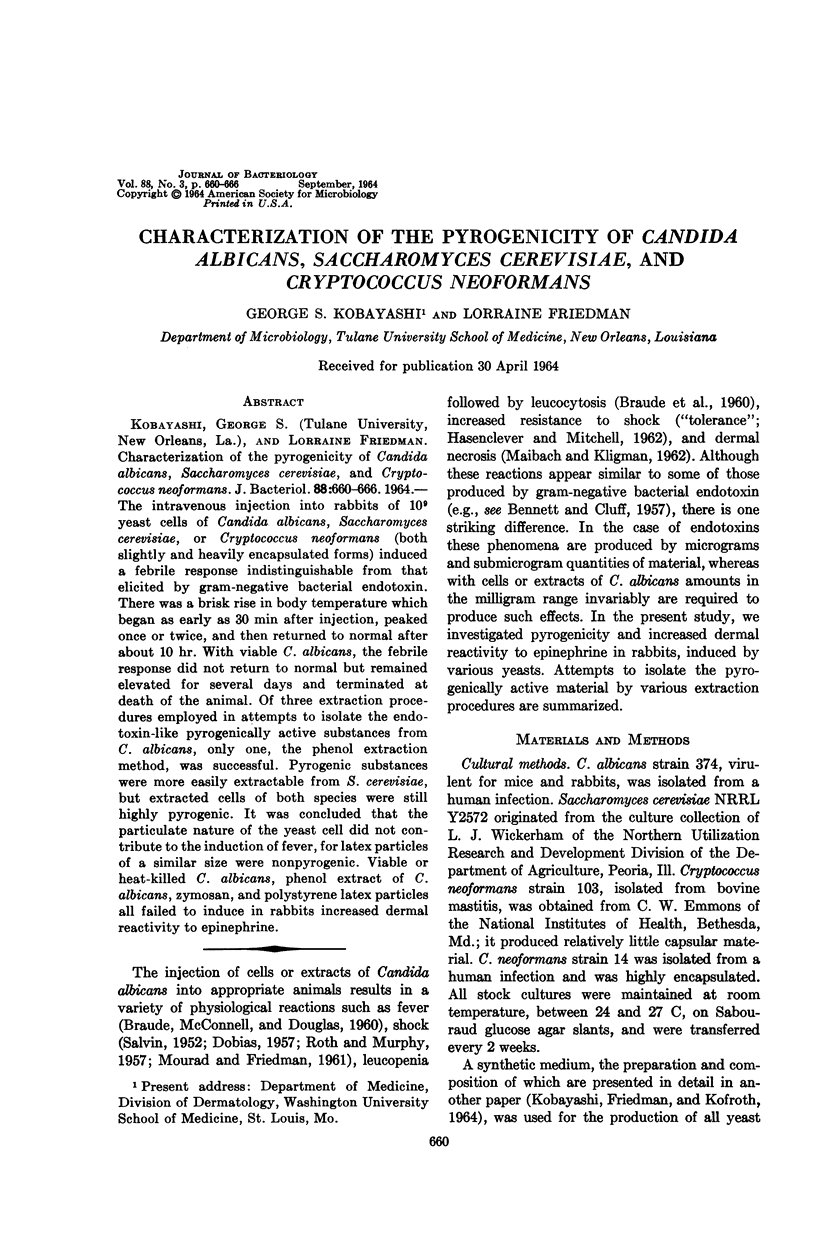
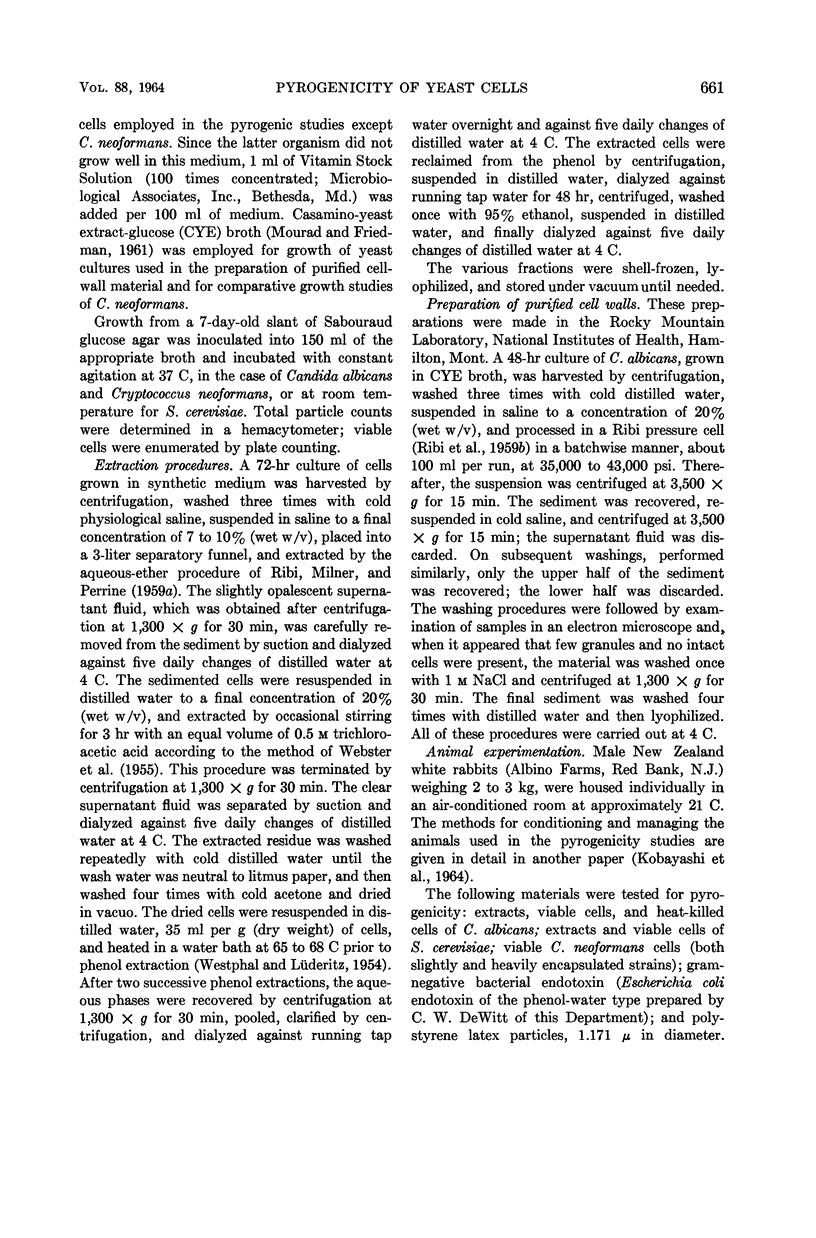
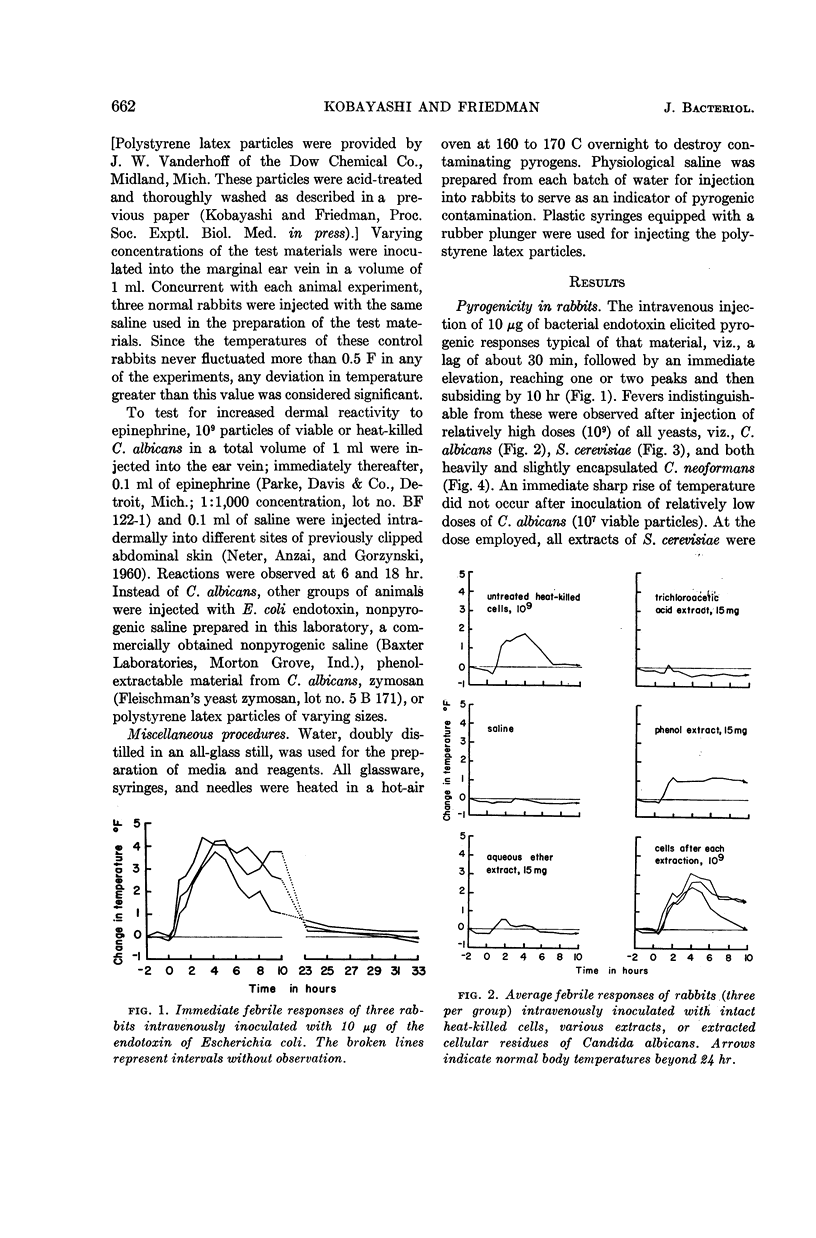
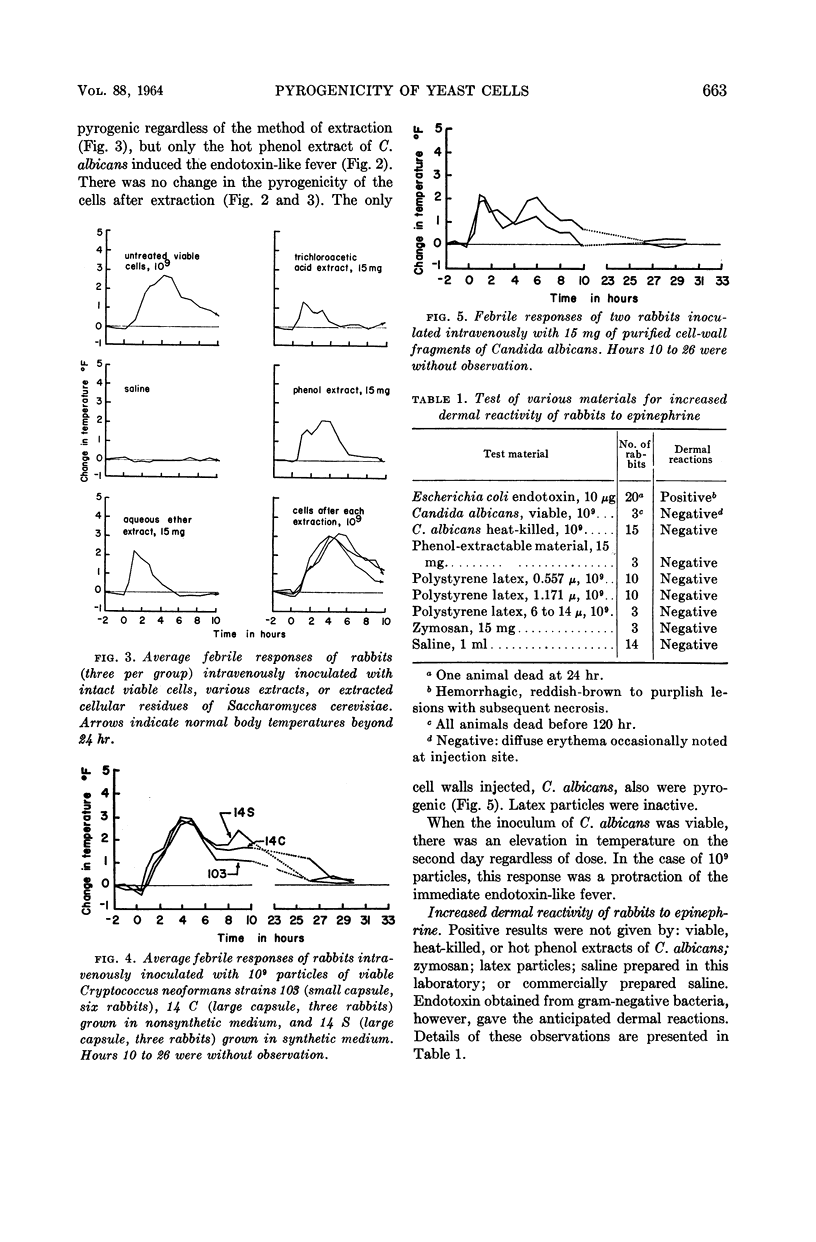
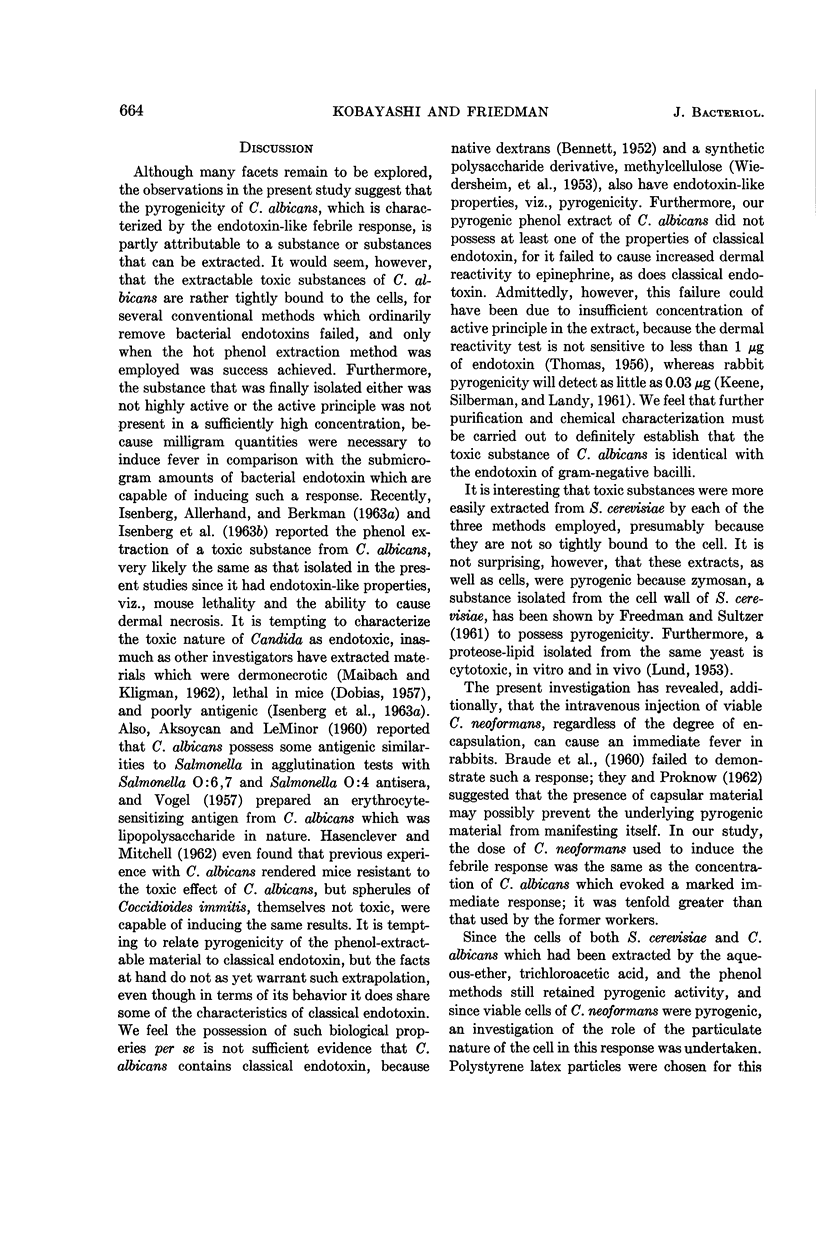
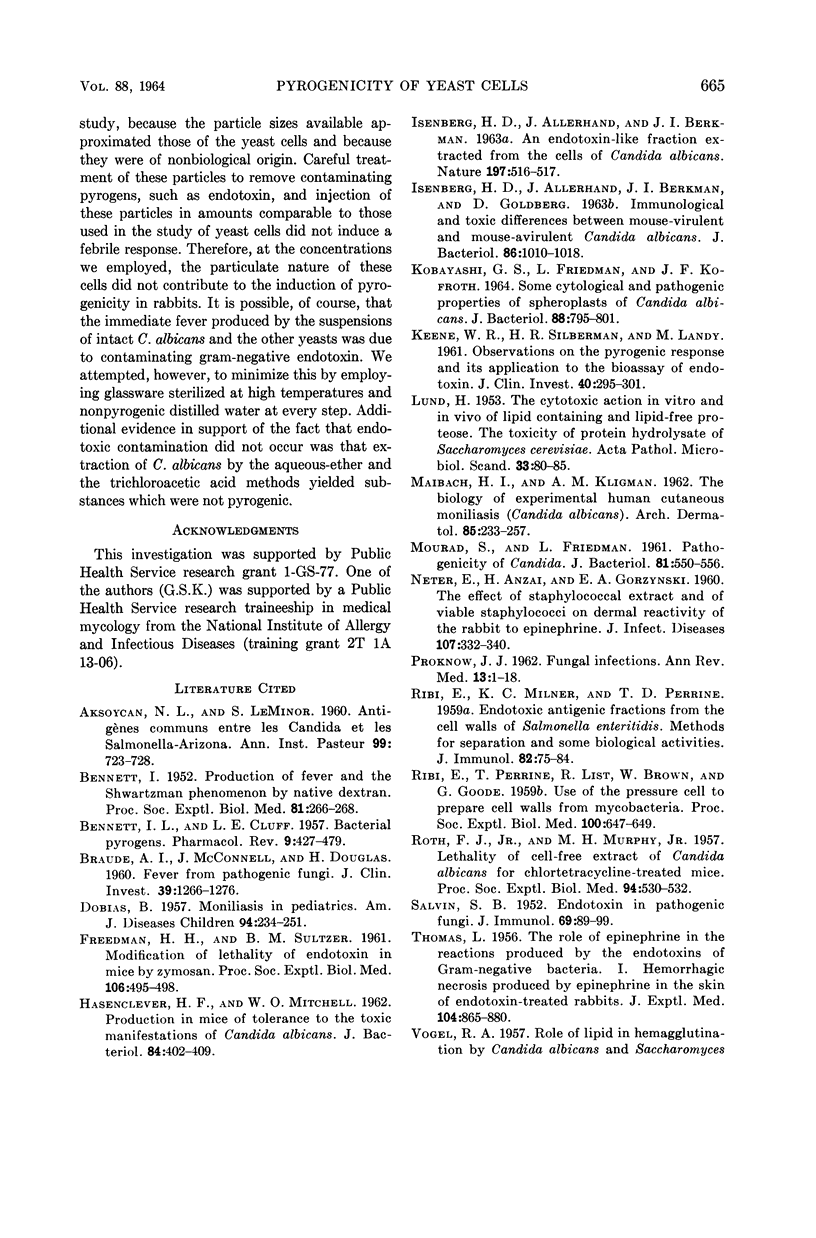
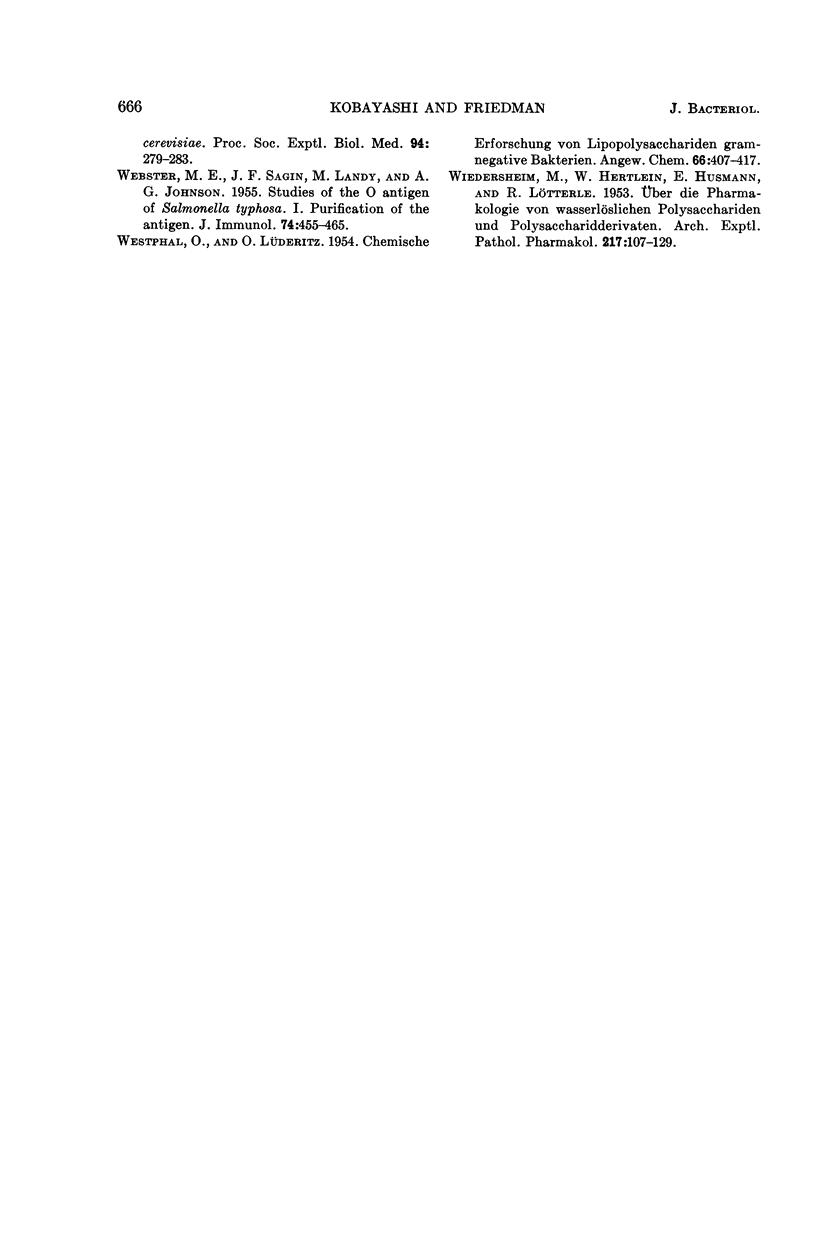
Selected References
These references are in PubMed. This may not be the complete list of references from this article.
- AKSOYCAN N., LE MINOR L., LE MINOR S. [Antigens common to the Candida and Salmonella-Arizona]. Ann Inst Pasteur (Paris) 1960 Nov;99:723–728. [PubMed] [Google Scholar]
- BENNETT I. L., Jr, CLUFF L. E. Bacterial pyrogens. Pharmacol Rev. 1957 Dec;9(4):427–479. [PubMed] [Google Scholar]
- BENNETT I. L., Jr Production of fever and the Shwartzman phenomenon by native dextran. Proc Soc Exp Biol Med. 1952 Oct;81(1):266–268. doi: 10.3181/00379727-81-19843. [DOI] [PubMed] [Google Scholar]
- BRAUDE A. I., McCONNELL J., DOUGLAS H. Fever from pathogenic fungi. J Clin Invest. 1960 Aug;39:1266–1276. doi: 10.1172/JCI104142. [DOI] [PMC free article] [PubMed] [Google Scholar]
- DOBIAS B. Moniliasis in pediatrics. AMA J Dis Child. 1957 Sep;94(3):234–251. doi: 10.1001/archpedi.1957.04030040016004. [DOI] [PubMed] [Google Scholar]
- FREEDMAN H. H., SULTZER B. M. Modification of lethality of endotoxin in mice by zymosan. Proc Soc Exp Biol Med. 1961 Mar;106:495–498. doi: 10.3181/00379727-106-26381. [DOI] [PubMed] [Google Scholar]
- HASENCLEVER H. F., MITCHELL W. O. Production in mice of tolerance to the toxic manifestations of Candida albicans. J Bacteriol. 1962 Sep;84:402–409. doi: 10.1128/jb.84.3.402-409.1962. [DOI] [PMC free article] [PubMed] [Google Scholar]
- ISENBERG H. D., ALLERHAND J., BERKMAN J. I., GOLDBERG D. IMMUNOLOGICAL AND TOXIC DIFFERENCES BETWEEN MOUSE-VIRULENT AND MOUSE-AVIRULENT CANDIDA ALBICANS. J Bacteriol. 1963 Nov;86:1010–1018. doi: 10.21236/ad0435722. [DOI] [PMC free article] [PubMed] [Google Scholar]
- KEENE W. R., SILBERMAN H. R., LANDY M. Observations on the pyrogenic response and its application to the bioassay of endotoxin. J Clin Invest. 1961 Feb;40:295–301. doi: 10.1172/JCI104256. [DOI] [PMC free article] [PubMed] [Google Scholar]
- KOBAYASHI G. S., FRIEDMAN L., KOFROTH J. F. SOME CYTOLOGICAL AND PATHOGENIC PROPERTIES OF SPHEROPLASTS OF CANDIDA ALBICANS. J Bacteriol. 1964 Sep;88:795–801. doi: 10.1128/jb.88.3.795-801.1964. [DOI] [PMC free article] [PubMed] [Google Scholar]
- LUND H. The cytotoxic action in vitro and in vivo of lipid-containing and lipid-free proteose; the toxicity of protein hydrolysate of Saccharomyces cerevisiae. Acta Pathol Microbiol Scand. 1953;33(1):80–85. [PubMed] [Google Scholar]
- MAIBACH H. I., KLIGMAN A. M. The biology of experimental human cutaneous moniliasis (Candida albicans). Arch Dermatol. 1962 Feb;85:233–257. doi: 10.1001/archderm.1962.01590020073009. [DOI] [PubMed] [Google Scholar]
- MOURAD S., FRIEDMAN L. Pathogenicity of Candida. J Bacteriol. 1961 Apr;81:550–556. doi: 10.1128/jb.81.4.550-556.1961. [DOI] [PMC free article] [PubMed] [Google Scholar]
- NETER E., ANZAI H., GORZYNSKI E. A. The effects of staphylococcal extract and of viable staphylococci on dermal reactivity of the rabbit to epinephrine. J Infect Dis. 1960 Nov-Dec;107:332–340. doi: 10.1093/infdis/107.3.332. [DOI] [PubMed] [Google Scholar]
- PROCKNOW J. J. Fungal infections. Annu Rev Med. 1962;13:1–18. doi: 10.1146/annurev.me.13.020162.000245. [DOI] [PubMed] [Google Scholar]
- RIBI E., MILNER K. C., PERRINE T. D. Endotoxic and antigenic fractions from the cell wall of Salmonella enteritidis; methods for separation and some biologic activities. J Immunol. 1959 Jan;82(1):75–84. [PubMed] [Google Scholar]
- RIBI E., PERRINE T., LIST R., BROWN W., GOODE G. Use of pressure cell to prepare cell walls from Mycobacteria. Proc Soc Exp Biol Med. 1959 Mar;100(3):647–649. doi: 10.3181/00379727-100-24730. [DOI] [PubMed] [Google Scholar]
- ROTH F. J., Jr, MURPHY W. H., Jr Lethality of cell-free extract of Candida albicans for chlortetracycline-treated mice. Proc Soc Exp Biol Med. 1957 Mar;94(3):530–532. doi: 10.3181/00379727-94-23002. [DOI] [PubMed] [Google Scholar]
- SALVIN S. B. Endotoxin in pathogenic q fungi. J Immunol. 1952 Jul;69(1):89–99. [PubMed] [Google Scholar]
- THOMAS L. The role of epinephrine in the reactions produced by the endotoxins of gram-negative bacteria. I. Hemorrhagic necrosis produced by epinephrine in the skin of endotoxin-treated rabbits. J Exp Med. 1956 Dec 1;104(6):865–880. doi: 10.1084/jem.104.6.865. [DOI] [PMC free article] [PubMed] [Google Scholar]
- VOGEL R. A. Role of lipid in hemagglutination by Candida albicans and Saccharomyces cerevisiae. Proc Soc Exp Biol Med. 1957 Feb;94(2):279–283. doi: 10.3181/00379727-94-22920. [DOI] [PubMed] [Google Scholar]
- WEBSTER M. E., SAGIN J. F., LANDY M., JOHNSON A. G. Studies on the O antigen of Salmonella typhosa. I. Purification of the antigen. J Immunol. 1955 Jun;74(6):455–465. [PubMed] [Google Scholar]
- WIEDERSHEIM M., HERTLEIN W., HUSEMANN E., LOTTERLE R. Uber die Pharmakologie von wasserlöslichen Polysacchariden und Polysaccharidderivaten. Naunyn Schmiedebergs Arch Exp Pathol Pharmakol. 1953 Jan 5;217(2):107–129. [PubMed] [Google Scholar]


